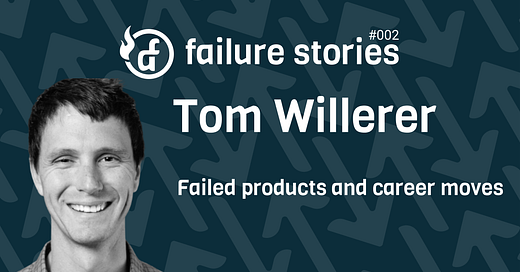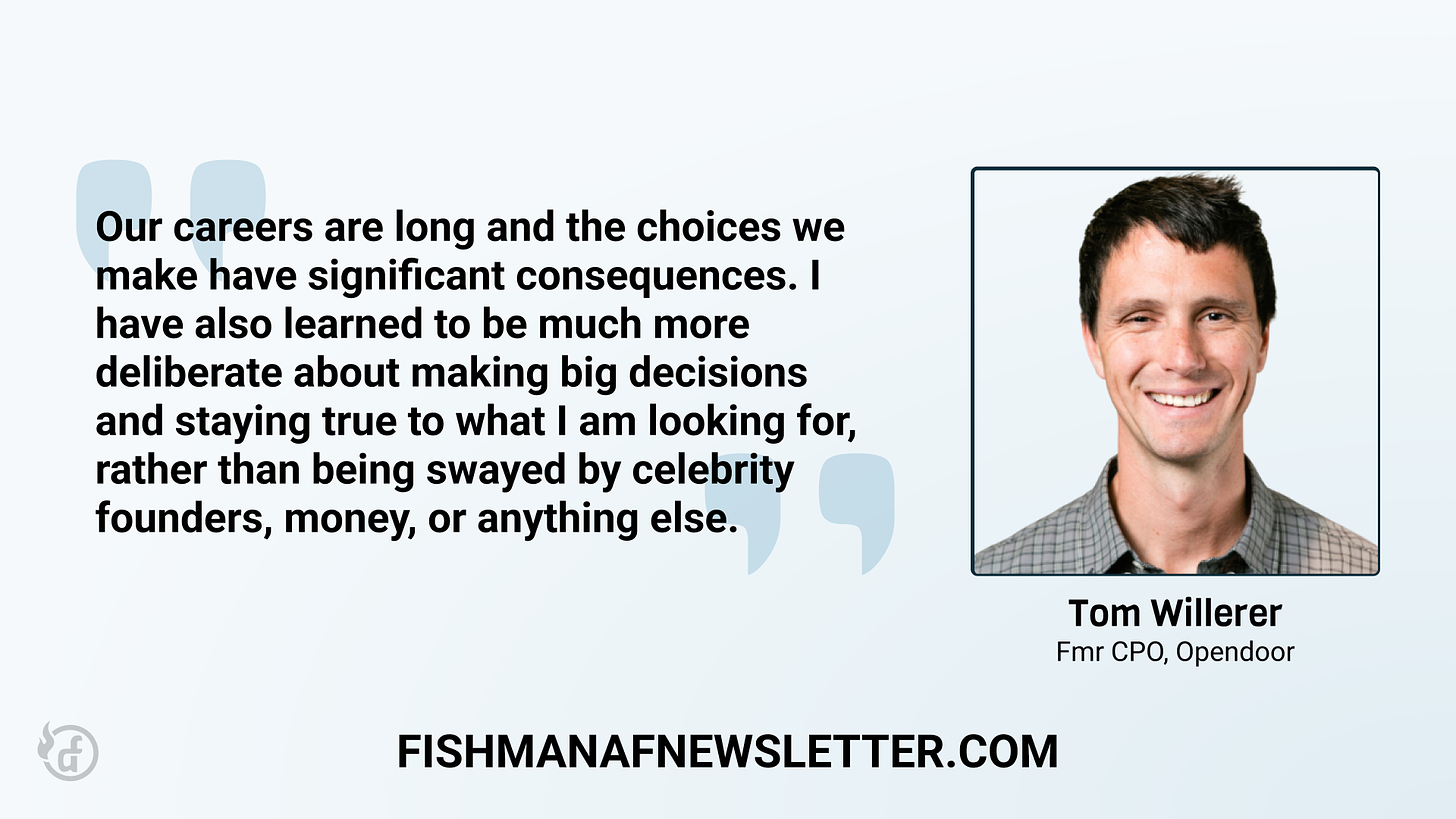
Failure Stories Volume 2
Tom Willerer’s lessons from Netflix and Facebook - a product executive shares his biggest product flop and a failed career move.
Hi there, it’s Adam. 🤗 Welcome to my weekly newsletter. I started this newsletter to provide a no-bullshit, guided approach to solving some of the hardest problems for people and companies. That includes Growth, Product, company building and parenting while working. Subscribe and never miss an issue. Listen to my new podcast about fatherhood and company leadership - Startup Dad. Questions? Ask them here.
Welcome to the second installment of Failure Stories. In my first installment I interviewed Elena Verna and Leah Tharin about their earlier failures and what they learned from them.
Failure. We’ve all experienced it but hate to talk about it. And why is that? Is it because as leaders we’re supposed to be flawless; impervious to criticism and mistakes?
Are we worried that if our teammates, peers, bosses or direct reports find out about some huge flop our ours that we will somehow be less successful than we were a week or two ago or that it might hold us back from that future career opportunity?
In Product we prototype because we know that on a great day only 30% of our solutions will actually work. In Growth we experiment for the same reason. Even the smartest and most talented among us get it wrong, have moments of immaturity, and learn some painful lessons.
The party line is that failure is “OK” because it’s about learning. But, when it comes down to it, is it really okay to fail?
Yes. It is. And because it’s so hard to admit failures I’m publishing this recurring series on the stories of some of the most successful leaders and the struggles along their journey to success. My hope is that this normalizes the losses and mistakes that we’ve all experienced but are too afraid to share. The ones that make us deeply uncomfortable and are a big part of what has forged the successful people you follow today. Those whose advice you clip and save for later, whose newsletters you subscribe to, and whose templates you share.
With each person I ask them two questions:
What would you consider to be the biggest professional failure of your career – what’s the story behind it and why was it such a big flop?
How did that experience shape you; how did you transform it into a learning opportunity?
Today I’m sharing two great stories from Tom Willerer – former CPO at Opendoor and Coursera and a product executive at Netflix. By all accounts Tom is an incredibly successful executive, but along the way he’s had some terrible product flops AND a failed 3-month career stint at Facebook. He shared these with me candidly and his biggest lessons learned.
Story 1: Netflix fails at social integrations
In 2012, Netflix was expanding internationally and Facebook was a pre-IPO, rapidly-growing social platform. Many companies were able to grow by leveraging the Facebook social graph. There are two notable examples. First is Spotify, which expanded into new regions by having users share what they were listening to on the Facebook platform. The second is Zynga, which grew the number of users for games like Farmville and Words With Friends by sharing the actions users took in the game on Facebook. Both of these companies skyrocketed their growth through exploiting the connected nature of the Facebook social graph.
Not to be left on the sidelines, Netflix wanted to try something similar. We wanted to to reduce reliance on paid marketing—which Netflix was spending hundreds of millions of dollars on—and grow virally on the fastest growing social platform. If Spotify and Zynga could do it, why not Netflix?
We had real business challenges that we believed Facebook could help solve, and Facebook was motivated to help. They gave Netflix a dedicated team and helped us launch an integration where Netflix members could link their Netflix and Facebook accounts.
By linking accounts, Nfetflix members would share everything they watched on Netflix to their Facebook feed [editor note: what could possibly go wrong?!] and they would get recommendations for what to watch based on what their friends were watching.
The latter had real utility, as people liked seeing what their friends were watching and it increased viewing hours; a core engagement metric for Netflix. However, people neither expected nor wanted everything they had watched to be posted to Facebook. This makes intuitive sense.
If I were to think about my own situation, I want people to think that I am very intellectual and only watch cerebral documentaries. However, in reality, I watch Seinfeld reruns, The Voice, and Say Yes to the Dress. Please do not judge me [editor’s note: we would never do that… … …]. Ultimately, this effort failed and we removed this functionality after toiling with it for over a year.
The year-long feature was a mistake for two reasons:
It wasted upwards of 20 people’s time building it out over a year.
Netflix’s motivation was to solve a business problem (reduce customer acquisition cost and go viral) and they ignored the customer. We definitely didn’t seek to understand if we were solving a problem for them.
How did that experience shape you; how did you transform it into a learning opportunity?
It is critical to begin projects by defining the customer’s problems, not just focusing on the business’ problems. Both are important, but without addressing the customer’s problems products will fail [editor note: I talk about this in Motion vs. Progress].
This can be difficult as we are overly focused on our own internal needs—like talking to teammates, looking at metrics, etc.— instead of spending time with customers. But it is essential to understand the customer’s problems in order to build products that solve both the customer’s problems and the business problems.
As builders, we need to be able to clearly articulate how what we are building both solves a real customer problem and a business problem (or creates an opportunity). If we can’t do both, our products will fail.
In summary, Netflix tried to grow virally by integrating with Facebook. But people didn’t want their viewing history automatically shared on Facebook and the integration was a complete failure. The mistake was to focus on business goals and ignore customer needs.
Story 2: A 3 month stint at Facebook
After six years at Netflix, where I helped transition the company from DVDs by mail to streaming and from a US-only business to an international one, I was ready to join a smaller company. I wanted to apply my experience in scaling Netflix to a much smaller organization.
However, I was convinced to join Facebook, which was younger than Netflix but much larger (at least twice as large). I left Facebook after three months to join Coursera, taking ownership of my mistake and the initiative to leave early.
I loved my time at Netflix and could have easily stayed longer, but I was also excited about going to a much smaller company and taking on an executive role where more of the accountability for the business was on my shoulders. I was also really excited about joining an early stage company and going through all the ups and downs that come with it.
I was approached by an ex-Netflix colleague who had recently joined Facebook. He sold me on the merits of Facebook and of working with him again. I met Mark Zuckerberg and he was amazing. I was woo’d and I let go of my startup intentions to join Facebook. I was hired to lead Product for Facebook Pages and a nascent Local strategy.
After joining the company and being thrust into “bootcamp” where I had to download the codebase and fix bugs, I was immediately unsure of my decision. I’m not an engineer, so you can understand why. I was then introduced to the “Zuck review” process which was a go/no-go meeting where Zuckerberg would bless any project the product teams were working on.
These meetings were great because Mark is a world-class leader, but they add bureaucracy and process, which is the antithesis of what I was seeking. Finally, within two months I experienced my first re-org and was no longer going to be doing what I was hired to do, though I did have great options if I were to have stayed at Facebook.
They are notorious for re-orgs but it was strange to experience it so shortly after joining. My experience at Facebook was not fulfilling my desire for the early stage vibes at all!
Meanwhile, my friend and former VP of People from Netflix had just joined Coursera and she reached out to me about a VP of Product role. I got excited about Coursera’s mission and size (Series A startup, less than $1m in revenue and fewer than 50 people) and decided that I shouldn’t fall for the sunk cost fallacy. It forced me to think hard about whether I should stay at Facebook or leave after only three months to join Coursera.
As odd as it was to leave a company after three months, and as bad of a decision as it was for me to join Facebook, I’m very happy that I made the decision to leave Facebook and join Coursera. I was employee number 50 and was able to grow into an executive role there while also setting the company up to grow from $1m to $100m in revenue and ultimately go public!
How did that experience shape you; how did you transform it into a learning opportunity?
I have learned that just because I made one bad decision I shouldn’t allow it to trap me into sticking with it. Our careers are long and the choices we make have significant consequences. I have also learned to be much more deliberate about making big decisions and staying true to what I am looking for, rather than being swayed by celebrity founders, money, or anything else [editor’s note: I write about this in The New PMF].
In summary, after six years at Netflix I left to join Facebook which was younger but twice as big. I left after three months for Coursera, admitting my mistake and quitting early. I didn’t let my bad decision trap me into sticking with it and now focus on staying true to what I’m looking for in my career moves.
If YOU have a failure story that you’d like to share or any feedback on this series please reply and let me know or send them to me here.









